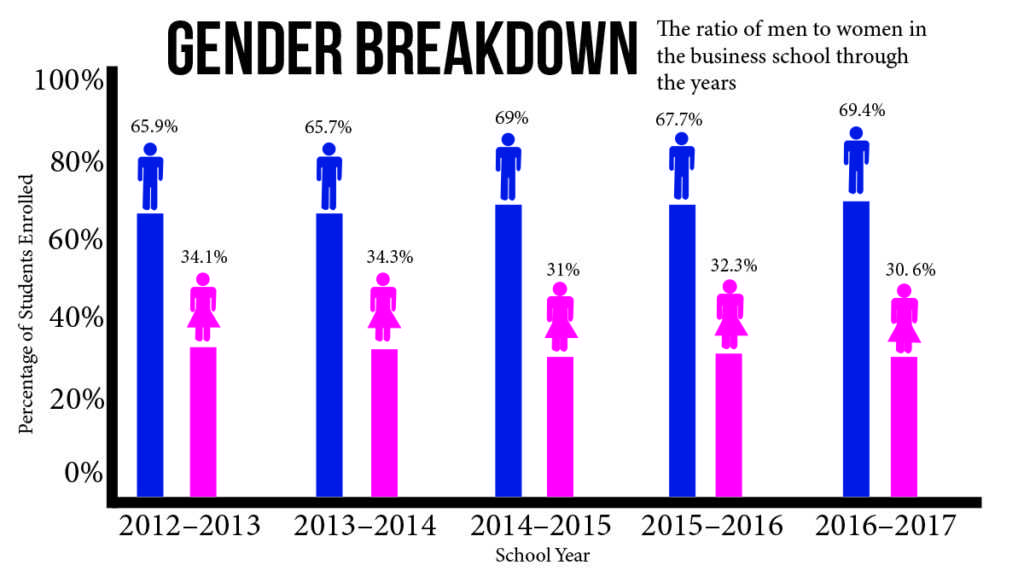Ithaca College’s School of Business female enrollment is the lowest it has been in five years, with women constituting 30.6 percent of students in the school.
Senior Windsor Lindsay, co-president of the Women in Business Network, said the gender gap is visible in the classroom, especially in her finance classes. She said it is common for her to be the only woman in her classes, and in one of the courses that all finance majors are required to take, her class only had one other female student besides her.
Out of the 670 students currently enrolled in the School of Business for the 2016–17 academic year, only 30.6 percent are female, according to the Office of Analytics and Institutional Research. For the 2016–17 academic year, there is a total of 458 male students enrolled in the School of Business, compared to 202 female students enrolled, according to institutional data.
Not only is female enrollment at the lowest it has been in five years, but it has also decreased by over 4 percent since 2012. In the 2015–16 academic year, 32.3 percent of the students enrolled were female; 2014–15, 31 percent; 2013–14, 34.3 percent; and 2012–13, 34.1 percent, according to institutional data.
Ithaca College’s proportion of female students in business is lower than the national average proportion of business degrees conferred to women, which has hovered around 50 percent since 2000, according to the National Center for Education Statistics 2013 Digest of Education Statistics.
Dawn Kline, assistant dean of the School of Business, said the gender gap is something the administration is always thinking about. She said the school has created initiatives to bring more women into programs such as finance — which is typically a male-dominated industry — including hosting alumnae who work in the industry and making sure there is a gender balance among the students who work in the school’s Trading Room, where students in the School of Business access real-time stock market information.
Though the administration does not know why business and administration majors skew toward men, she said it is looking to balance the gender gap. One way the School of Business does this is through staffing admissions and recruitment events with female business majors.
“I’m not sure what else we can do from an admissions standpoint,” Kline said. “I think it’s probably not in the admit side of things, but in the why students ultimately pick IC, and are there things we can do to be more attractive for female students?”
Warren Schlesinger, associate professor of accounting, said that in his 35 years at the college, there have always typically been more male students than female students, and although there is some awareness regarding the gender gap, it has not been a major source of concern or focus of the program. He said the school intentionally has a diverse group of student presenters at recruitment events and that there have been exceptional female presenters in recent years.
“What we’re hoping, of course, is that high school students who are out there in the audience and looking at different colleges, and they see these outstanding young women talking about their experiences in the classroom and internships and study abroad — they can see themselves coming to Ithaca College and having that kind of success,” Schlesinger said.
Freshman Julia Schmidt, a business administration major, said that when she attended Ithaca Today — a weekend-long event the college holds to welcome accepted students — the student speakers she listened to were both female, which she said sets a positive example for prospective students.
“If you’re a girl and you see a woman do something successful, it’s easier to picture yourself doing that than if it was a man because it is easier to relate,” Schmidt said. “[It] probably wouldn’t have been the same if it was a guy.”
The Women in Business Network — which has about 60 active members — states its mission is “to emphasize the importance of women in business and leadership.” Lindsay said the club is important because there are so few women in the school and the club provides a supportive environment for its female members. The club also provides a place where women can discuss the challenges of being a woman in the business world and gain the skills to combat those challenges. These issues include sexism, sexual harassment, the wage gap and climbing the corporate ladder, Lindsay said. She said these issues are not talked about in the classroom and that the club provides an opportunity to address these challenges.
“[Classes] are not going to talk about the social construction of the professional environment, and it makes it difficult for women to rise up,” Lindsay said. “In Women in Business, that’s the whole point: We kind of talk about the unspoken issues that women will face. On top of that, it’s not all the negatives — we also focus on professional development. So basically, a way that women can combat the sexist environment they might face, but also how they can be very successful.”
Lindsay said the gender gap exists because of a lack of female interest, not because the School of Business is denying female students. She said based on social constructions, business is not a field women are traditionally drawn to. The School of Business needs to encourage and make known the opportunities available to prospective students and exploratory students, especially female students, Lindsay said.
Junior Emma Hyland, a business administration major, said there is a significant gender gap in her classes. Hyland said that when she applied, she was aware the college had more women — 57 percent of the college is made up of women — but she was unaware of the low percentage of women in the business school.
“I do see that men are more likely to participate [in class] than females are — I have noticed that before,” Hyland said.
A 2016 study “Women in the Workplace,” conducted by Leanin.org and McKinsey & Company, studied data from 136 companies, coupled with 34,000 employee surveys, with the goal of promoting gender equality in the workplace. The study found that women are less likely to be hired and promoted than their male counterparts. At the entry–level, women made up 46 percent of the workforce, but women constituted 37 percent of managerial positions. These statistics are even lower for women of color, with only 17 percent of entry–level workers being women of color and only 12 percent being promoted to managerial positions.
“Compared to men, they are less likely to think they have equal opportunities for growth and development — and more likely to think their gender will play a role in missing out on a raise, promotion or chance to get ahead,” according to the study.
Sophomore Luciarose Barone said the gender gap makes her feel like she has to work harder in the classroom and to succeed in her field.
“I’m an accounting major, and that’s not very popular to begin with, so I feel like I have to work harder to be where I want to be compared to [men],” Barone said.








